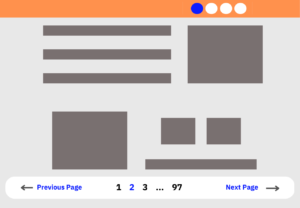In today’s digital age, there are essential web design tips where the concept of boundaries is gradually fading. The Internet has interconnected businesses and customers in ways we never thought possible a couple of decades ago. If you are a business aiming to expand its horizons and tap into the international market, your website’s design plays a pivotal role in making that first impression.
In today’s world, knowing how to do web design is becoming increasingly important and indispensable for designers. Web design can be pretty complex and daunting, but with the development of the Internet and technology, web design can be more accessible than ever. Fortunately, there are many resources on the Internet, and everyone can learn to be a great web designer independently.
There are many prototyping and design tools for you to choose to create your website. As beginners, you must select a creative tool that is easy to use and offers various built-in components, which can help you quickly get a first visual impression of your future website. With such application tools, you don’t have to wait for the final screen design; you can validate your ideas within minutes.
Basic knowledge about interaction design, like creating design plans, identifying key wireframes, and prototype interactions, is vital. For your information, Fabi Gylgonyl of International SEO Agency spoke at a conference in London about web design tips for international businesses to enable them to speak a global language honestly. Let’s consider Fabi’s advice for business owners.
The Topmost Web Design Tips For International Business Webmasters To Utilize
Unfortunately, many young webmasters or new designers often misunderstand the web design concept. To enumerate, web design refers to the design of websites displayed on the Internet. It usually refers to the user experience aspects of website development rather than software development. Therefore, even someone without technical knowledge can become a great web designer.
Using platforms like Mockplus, Figma, or Sketch is incredibly possible. Of course, it would be great to know some coding language (HTML, CSS, Java), but you can’t get yourself deep into front-end development; that’s not the core of web design. Usually, the core of web design is visual and interaction. It aims to solve the communication problems between users and web page information.
As young designers, you may feel confused about what skills to master when you start your career. Simply speaking, visual design improves the UI and UX of a website/application through visual elements and effects. More so, including colors, illustrations, photography, typography, layouts, white spaces, etc. In contrast to UI design, it focuses more heavily on the visual effects.
Mainly, it focuses on the visuals of the website/application design and aims to engage users. As beginners, if you want a great graphic design, you must bear the basic principles of scale, visual hierarchy, balance, contrast, and gestalt, which can help you drive engagement and increase usability. With that in mind, a few web design tips can help you achieve that, such as follows.
1. Embrace Cultural Sensitivity In Design
Dive deeper than surface-level translations. Usually, the color schemes, symbols, and even the choice of images can carry profound cultural connotations that might vary significantly across regions. Take the color white, for instance. In Western cultures, it’s often associated with purity and peace. Yet, in some Asian cultures, white is the color of mourning. Similarly, a thumbs-up gesture might be a sign of approval in many countries but can be considered rude in others. When designing, it’s essential to be mindful of these nuances. By doing so, you aren’t just creating a website but an experience that feels local and authentic.
2. Design with Flexible Layouts for Various Scripts
Language scripts aren’t uniform. While English and most European languages are read from left to right, languages like Arabic and Hebrew go from right to left. When expanding internationally, your website should be equipped to adjust its layout based on the linguistic preferences of the audience. Imagine reading a book where the narrative keeps switching direction – sounds disorienting, right? Ensure your international visitors never feel that way on your site.
3. Local Search Engines Matter
While Google reigns supreme in many parts of the globe, it’s not the default everywhere. In China, Baidu takes the lead. In Russia, Yandex is the preferred choice. Knowing where your potential customers are searching online is crucial to venturing into new territories. Tailor your SEO strategies accordingly. Think of it like this: Even the most enticing shop won’t see customers if it’s located in a secluded alley. Make sure your website is easily discoverable on the platforms that matter. If you are entering a complex market like Russia, it may be wise to hire the services of quality local agencies like russianseoagency.com monthly.
4. Multilingual Support Is Non-Negotiable
A conversation feels more intimate and genuine when conducted in one’s native language. Extend this principle to your website by offering multilingual support. And remember, languages have nuances, too. The Spanish spoken in Barcelona differs from the one spoken in Buenos Aires. By addressing these subtleties, you’re rolling out a red carpet for your international visitors, making them feel valued and understood.
5. Prioritize Localized Content
While having a global appeal is essential, there’s immense value in localized content. Whether celebrating a local festival, recognizing regional achievements, or sharing content related to local trends, such elements add a personal touch. It’s like attending a global conference and finding someone who knows and appreciates your hometown’s little-known coffee shop.
6. Ensure Smooth Payment Integrations
Finally, while content and design are vital, the end goal for most businesses is conversion. Different regions have varied preferred payment methods. While credit cards might be predominant in the US, other countries might lean towards digital wallets or direct bank transfers. Integrating these payment options can be a customer’s final nudge to purchase.
In Conclusion:
As stated, web design is not about software systems development; you do not have to get deep into front-end development. However, as a designer, having basic programming knowledge allows you to collaborate with developers more efficiently. Whether you are a beginner or a professional designer, your design aims to present the value of your product or business to your customers.
So, the last but least important skill for a designer is to have a clear persona and create a design that meets your customers’ needs. Equally important, the overall look of your website is a crucial component of web design. Studies find that users take only 50 milliseconds to form an opinion of your website or business, and that will determine whether they’ll stay or leave.
Therefore, you must keep your design simple, clean, and accessible. At the same time, use grid-based designs to keep design items organized and orderly, thus creating a great overall layout. Be that as it may, after you master all the creative skills and website design/development tips above, it’s time to turn the page on that sketchbook and start your website design/development project.
Remember, you can’t be a web designer by tooling around. Whether you are a beginning designer or a professional designer, you must remember that learning is the only way to achieve your goal. Just take your time to learn and be a professional designer. If you want to learn website design/development at home to hone your skills, various credible resources online can help you out for free.








We at DigiAvenir are passionate about assisting companies in thriving in the digital environment. We offer creative solutions that help our clients achieve their goals by leveraging our skills in website building, digital marketing, and market research.
Comments are closed.